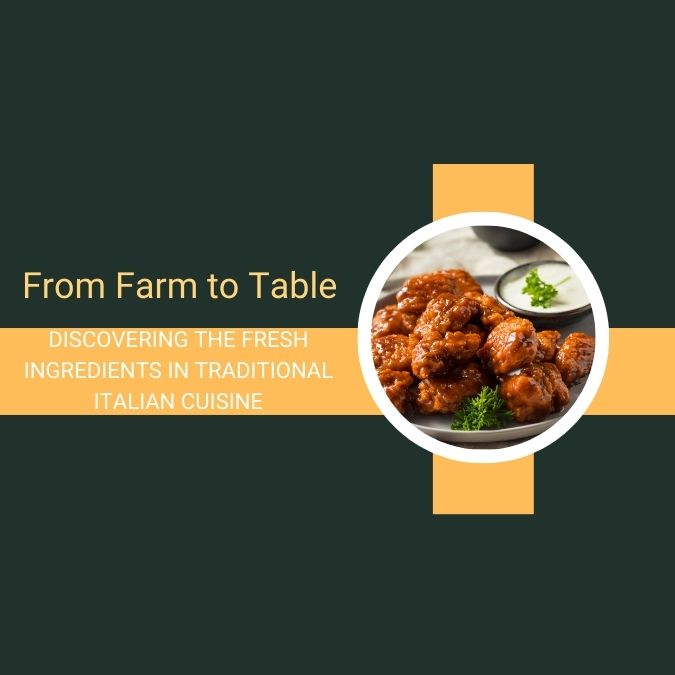Italy is famous around the world for its delectable cuisine, and at the heart of every conventional Italian dish lies the usage of fresh, locally sourced stuff. In this culinary journey, we’ll discover the rich ritual of iconic Italian dishes and how the farm-to-table philosophy recreates an integral role in making those mouthwatering tastes.
The Italian Culinary Tradition: A Glimpse into its Essence
Italian cooking is prominent for being both rustic and refined, a contradiction that stems from its deep-rooted culinary practices. Time-honored Italian cuisine is a celebration of simplicity, with plates that rely on a handful of fresh, top-notch ingredients. Central to this approach is the concept of peasant cuisine, which emphasizes taking advantage of what’s available locally to make flavorful, satisfying meals.
The Role of Fresh Ingredients: An Italian Staple
At the core of Italian cuisine is the dedication to utilizing fresh stuff. Italians take great pride in sourcing food from local markets, farms, and artisans. It not only boosts the flavors but also supports local communities and retains the atmosphere.
The Italian Farm-to-Table Philosophy
Local Produce and Seasonality
The Italian farm-to-table philosophy is profoundly rooted in the usage of regional produce and a keen grasp of seasonality. Ingredients are picked depending on what’s ripe and ready, resulting in plates bursting with flavor. For instance, in the spring, you might discover deep asparagus and tender artichokes gracing your plate, while autumn brings an abundance of earthy mushrooms and hearty root veggies.
The Importance of Fresh Herbs
Fresh herbs like basil, oregano, and rosemary are vital in Italian cooking. They are usually grown in house gardens or bought at local markets. The usage of these herbs not only adds depth to the flavors but also provides numerous health perks.
Pasta: The Quintessential Italian Ingredient
Pasta is a staple in Italian cuisine, and it’s traditionally made from just two components: durum wheat semolina and water. The simplicity of these recipes allows the pasta to shine and pairs wonderfully with diverse sauces and toppings. Freshly made pasta is a delicacy worth savoring.
The Farm Connection: Supporting Local Producers
Cheese and Dairy Products
Italy is well-known for its cheeses, from creamy mozzarella to aged Parmigiano-Reggiano. Local dairies and cheese producers play a pivotal role in offering brand-quality dairy products for Italian cooking. The rich milk from local cows, sheep, and goats forms the base of these delicious cheeses.
The Art of Olive Oil Production
Olive oil is the lifeblood of Italian cooking. Olive groves are scattered throughout the country, and local artisans mindfully cultivate and press the olives to make extra virgin olive oil, a key ingredient in numerous dishes. The regional variations in olive oil tastes add complexity to Italian cuisine.
Wine: A Culinary Companion
Italy boasts a comprehensive spectrum of wine regions, each producing exceptional varietals. Wine is an essential part of Italian dining, elevating the flavors of food and complementing the meal. Local vineyards take pride in preparing wines that pair perfectly with regional dishes.
Traditional Italian Dishes: A Showcase of Freshness
Insalata Caprese
This traditional Italian salad exemplifies the farm-to-table concept. Fresh tomatoes, mozzarella cheese, as well as basil leaves, are drizzled with olive oil and balsamic vinegar, making a symphony of plates that capture the essence of Italian cooking.
Risotto alla Milanese
Milanese risotto is a testament to the significance of refreshed ingredients. Arborio rice, saffron, and homemade chicken or vegetable broth blend to create a creamy, vibrant dish that’s a joy to the palate.
Pizza Margherita
The simplicity of a Margherita pizza lets the components shine. Fresh tomato sauce, mozzarella, basil, and a drizzle of olive oil on a thin, crispy crust make a taste sensation that’s synonymous with Italy.
The Joy of Regional Variations
Tuscany: Simplicity and Elegance
Perhaps it is famous for its rustic cooking, characterized by its usage of simple, fresh ingredients. Dishes, a hearty vegetable soup, and pappa al pomodoro, a tomato and bread soup, epitomize the Tuscan farm-to-table tradition.
Sicily: An Explosion of Flavors
Sicilian cuisine is a melting pot of tastes influenced by Mediterranean, Arab, and North African cultures. Plates like caponata, created from eggplant, and arancini, fried rice balls, showcase the island’s vibrant stuff.
Savoring the Italian Farm-to-Table Experience
Conventional Italian cooking is a testament to the attractiveness of simplicity and the essence of fresh, local stuff. From the rolling hills of Tuscany to the sun-drenched coasts of Sicily, Italy’s culinary practices provide a taste of the country’s rich culture and history.
When folks sit down to enjoy a plate of pasta or a slice of pizza in Italy, they’re not just savoring a meal; they’re experiencing an in-depth bond to the land, the people, and the centuries-old practices that make Italian cuisine truly special. So, the next time you dine on classic Italian fare, take a moment to have fun with the journey these stuff have made, from farm to table, to grace your crock with their fantastic flavors.

